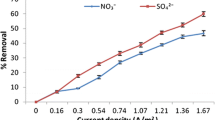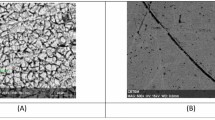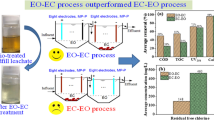Abstract
This study aims to determine the effects of initial pollutant concentration level (1/1–1/4), flow rate (10–40 mL/min), NaCl concentration (0.1–1 M), pH (3–9) and current density (4.73–23.67 mA/cm2) parameters on the removals of total suspended solids, total organic carbon, chemical oxygen demand, total nitrogen and color for economic treatment of cattle-abattoir wastewater using mesh-type Ti/Pt anodes with continuous EO system. Total suspended solids, total organic carbon, chemical oxygen demand, total nitrogen and color analyses were carried out according to photometric method, catalytic oxidation method, closed reflux colorimetric method, nitrogen cell test method and platinum–cobalt method, respectively. The effluent chloride levels were analyzed according to the argentometric titration method. According to results, all operational parameters had an impact on removal efficiencies but the most effective parameters on energy consumption were NaCl concentration and applied current density. Although two possible system conditions were determined according to removal efficiencies the operating conditions with the lowest energy consumption are considered to be optimal. The optimum operating conditions were determined as NaCl concentration of 1 M, CD of 4.73 mA/cm2, initial pH of 7.03, reaction temperature of 25 °C and FR of 10 mL/min. Under these conditions removal efficiencies (%) for total suspended solids, total organic carbon, chemical oxygen demand, total nitrogen and color were found as; 98.28, 93.03, 97.44, 95.53 and 99.80, respectively. The energy consumption values were calculated as 2.42 kWh/kg COD and 19.43 kWh/m3. The approximate cost to treat 1 m3 wastewater was calculated as $ 6.43. The kinetic behavior abided by a pseudo-first-order model.







Similar content being viewed by others

Change history
18 April 2022
A Correction to this paper has been published: https://doi.org/10.1007/s13762-022-04177-w
References
Ademoroti CMA (1996) Standard method for water and effluent analysis. March Prints and Consultancy, Foludex Press Limited, Ibadan, p 182
Ahmadian M, Yousefi N, Van Ginkel SW, Zare MR, Rahimi S, Fatehizadeh A (2012) Kinetic study of slaughterhouse wastewater treatment by electrocoagulation using Fe electrodes. Water Sci Technol 66(4):754–760. https://doi.org/10.2166/wst.2012.232
Alfonso-Muniozguren P, Cotillas S, Boaventura RA, Moreira FC, Lee J, Vilar VJ (2020) Single and combined electrochemical oxidation driven processes for the treatment of slaughterhouse wastewater. J Clean Prod. https://doi.org/10.1016/j.jclepro.2020.121858
Al-Mutairi NZ, Hamoda MF, Al-Ghusain IA (2003) Performance-based characterization of contact stabilization process for slaughterhouse wastewater. J Environ Sci Healt A 38:2287–2300. https://doi.org/10.1081/ESE-120023376
Anglada A, Urtiaga A, Ortiz I (2009) Contributions of electrochemical oxidation to waste-water treatment: fundamentals and review of applications. J Chem Technol Biot 84(12):1747–1755. https://doi.org/10.1002/jctb.2214
APHA (2005) Standard methods for examination of water and wastewater, 21st edn. American Public Health Association, Water Environment Federation Publication, Washington, DC
Awang ZB, Bashir MJK, Kutty SRM, Isa MH (2011) Post-treatment of slaughterhouse wastewater using electrochemical oxidation. Res J Chem Environ 15(2):229–237
Azarian G, Miri M, Nematollahi D (2018) Combined electrocoagulation/electrooxidation process for the COD removal and recovery of tannery industry wastewater. Environ Prog Sustain Energy 37(2):637–644. https://doi.org/10.1002/ep.12711
Baker BR, Mohamed R, Al-Gheethi A, Aziz HA (2020) Advanced technologies for poultry slaughterhouse wastewater treatment: a systematic review. J Disper Sci Technol. https://doi.org/10.1080/01932691.2020.1721007
Bashir MJ, Lim JH, Amr SSA, Wong LP, Sim YL (2019) Post treatment of palm oil mill effluent using electro-coagulation-peroxidation (ECP) technique. J Clean Prod 208:716–727. https://doi.org/10.1016/j.jclepro.2018.10.073
Bayramoglu M, Kobya M, Eyvaz M, Senturk E (2006) Technical and economic analysis of electrocoagulation for the treatment of poultry slaughterhouse wastewater. Sep Purif Technol 51:404–408. https://doi.org/10.1016/j.seppur.2006.03.003
Bazrafshan E, Mahvi AH, Zazouli MA (2011) Removal of zinc and copper from aqueous solutions by electrocoagulation technology using iron electrodes. Asian J Chem 23(12):5506–5510
Bui HM (2018) Applying response surface methodology to optimize the treatment of swine slaughterhouse wastewater by electrocoagulation. Pol J Environ Stud 27(5):1975–1981. https://doi.org/10.15244/pjoes/78440
Bustillo-Lecompte CF, Mehrvar M (2015) Slaughterhouse wastewater characteristics, treatment, and management in the meat processing industry: a review on trends and advances. J Environ Manage 161:287–302. https://doi.org/10.1016/j.jenvman.2015.07.008
Deborde M, Von Gunten URS (2008) Reactions of chlorine with inorganic and organic compounds during water treatment-kinetics and mechanisms: a critical review. Water Res 42(1–2):13–51. https://doi.org/10.1016/j.watres.2007.07.025
Deng F, Qiu S, Zhu Y, Zhang X, Yang J, Ma F (2019) Tripolyphosphate-assisted electro-Fenton process for coking wastewater treatment at neutral pH. Environ Sci Pollut Res 26(12):11928–11939. https://doi.org/10.1007/s11356-019-04548-w
Eryuruk K, Un UT, Ogutveren UB (2018) Electrochemical treatment of wastewaters from poultry slaughtering and processing by using iron electrodes. J Clean Prod 172:1089–1095. https://doi.org/10.1016/j.jclepro.2017.10.254
Fajardo AS, Martins RC, Silva DR, Quinta-Ferreira RM, Martínez-Huitle CA (2017) Electrochemical abatement of amaranth dye solutions using individual or an assembly of flow cells with Ti/Pt and Ti/Pt-SnSb anodes. Sep Purif Technol 179:194–203. https://doi.org/10.1016/j.seppur.2017.01.029
Garcia-Segura S, Ocon JD, Chong MN (2018) Electrochemical oxidation remediation of real wastewater effluents-a review. Process Saf Environ 113:48–67. https://doi.org/10.1016/j.psep.2017.09.014
Gharbani P, Tabatabaii SM, Mehrizad A (2008) Removal of Congo red from textile wastewater by ozonation. Int J Environ Sci Technol 5(4):495–500. https://doi.org/10.1007/BF03326046
Ghazouani M, Akrout H, Bousselmi L (2017) Nitrate and carbon matter removals from real effluents using Si/BDD electrode. Environ Sci Pollut Res 24(11):9895–9906. https://doi.org/10.1007/s11356-016-7563-7
Giwa A, Jung SM, Kong J, Hasan SW (2019) Combined process of electrically-membrane bioreactor and TiO2 aerogel filtration for efficient wastewater treatment. J Water Process Eng 28:107–114. https://doi.org/10.1016/j.jwpe.2019.01.009
Gotsi M, Kalogerakis N, Psillakis E, Samaras P, Mantzavinos D (2005) Electrochemical oxidation of olive oil mill wastewaters. Water Res 39(17):4177–4187. https://doi.org/10.1016/j.watres.2005.07.037
Harris PW, McCabe BK (2015) Review of pre-treatments used in anaerobic digestion and their potential application in high-fat cattle slaughterhouse wastewater. Appl Energy 155:560–575. https://doi.org/10.1016/j.apenergy.2015.06.026
Hodaifa G, Gallardo PAR, García CA, Kowalska M, Seyedsalehi M (2019) Chemical oxidation methods for treatment of real industrial olive oil mill wastewater. J Taiwan Inst Chem E 97:247–254. https://doi.org/10.1016/j.jtice.2019.02.001
Ilgin P, Ozay O (2017) Novel stimuli-responsive hydrogels derived from morpholine: synthesis, characterization and absorption uptake of textile azo dye. Iran Polym J 26(6):391–404. https://doi.org/10.1007/s13726-017-0528-y
Johns MR (1995) Developments in wastewater treatment in the meat processing industry: a review. Bioresour Technol 54(3):203–216. https://doi.org/10.1016/0960-8524(95)00140-9
Kapałka A, Katsaounis A, Michels NL, Leonidova A, Souentie S, Comninellis C, Udert KM (2010) Ammonia oxidation to nitrogen mediated by electrogenerated active chlorine on Ti/PtOx-IrO2. Electrochem Commun 12(9):1203–1205. https://doi.org/10.1016/j.elecom.2010.06.019
Kent J, Tay JH (2019) Treatment of 17α-ethinylestradiol, 4-nonylphenol, and carbamazepine in wastewater using an aerobic granular sludge sequencing batch reactor. Sci Total Environ 652:1270–1278. https://doi.org/10.1016/j.scitotenv.2018.10.301
Kul S, Boncukcuoğlu R, Yilmaz AE, Fil BA (2015) Treatment of olive mill wastewater with electro-oxidation method. J Electrochem Soc 162(8):G41–G47. https://doi.org/10.1149/2.0451508jes
Kumar S, Singh S, Srivastava VC (2015) Electro-oxidation of nitrophenol by ruthenium oxide coated titanium electrode: parametric, kinetic and mechanistic study. Chem Eng J 263:135–143. https://doi.org/10.1016/j.cej.2014.11.051
Lahkimi A, Oturan MA, Oturan N, Chaouch M (2007) Removal of textile dyes from water by the electro-Fenton process. Environ Chem Lett 5(1):35–39. https://doi.org/10.1007/s10311-006-0058-x
Li X, Cui Y, Feng Y, Xie Z, Gu J (2005) Reaction pathways and mechanisms of the electrochemical degradation of phenol on different electrodes. Water Res 39(10):1972–1981. https://doi.org/10.1016/j.watres.2005.02.021
Maljaei A, Arami M, Mahmoodi NM (2009) Decolorization and aromatic ring degradation of colored textile wastewater using indirect electrochemical oxidation method. Desalination 249(3):1074–1078. https://doi.org/10.1016/j.desal.2009.05.016
Martínez-Huitle CA, Brillas E (2009) Decontamination of wastewaters containing synthetic organic dyes by electrochemical methods: a general review. Appl Catal B Environ 87(3–4):105–145. https://doi.org/10.1016/j.apcatb.2008.09.017
Martínez-Huitle CA, Ferro S (2006) Electrochemical oxidation of organic pollutants for the wastewater treatment: direct and indirect processes. Chem Soc Rev 35(12):1324–1340. https://doi.org/10.1039/B517632H
Martínez-Huitle CA, Panizza M (2018) Electrochemical oxidation of organic pollutants for wastewater treatment. Curr Opin Electrochem 11:62–71. https://doi.org/10.1016/j.coelec.2018.07.010
Mohan N, Balasubramanian N, Basha CA (2007) Electrochemical oxidation of textile wastewater and its reuse. J Hazard Mater 147(1–2):644–651. https://doi.org/10.1016/j.jhazmat.2007.01.063
Montgomery J (1985) Water treatment: principles and design, 1st edn. Wiley, New York
Muddemann T, Haupt D, Sievers M, Kunz U (2019) Electrochemical reactors for wastewater treatment. ChemBioEng Rev 6(5):142–156. https://doi.org/10.1002/cite.201800193
Mulimi LK, Home PG, Chacha JS, Siringi DO (2020, February) Investigating electrocoagulation as an alternative treatment method for wastewater from Slaughterhouses in Kenya. In: Proceedings of sustainable research and innovation conference, pp 142–150
Nery VD, Damianovic MHZ, Pozzi E, De Nardi IR, Caldas VEA, Pires EC (2013) Long-term performance and operational strategies of a poultry slaughterhouse waste stabilization pond system in a tropical climate. Resour Conserv Recycl 71:7–14. https://doi.org/10.1016/j.resconrec.2012.11.006
Orssatto F, Ferreira Tavares MH, Manente da Silva F, Eyng E, Farias Biassi B, Fleck L (2017) Optimization of the pretreatment of wastewater from a slaughterhouse and packing plant through electrocoagulation in a batch reactor. Environ Technol 38(19):2465–2475. https://doi.org/10.1080/09593330.2016.1266036
Öztürk D, Şahan T (2015) Design and optimization of Cu (II) adsorption conditions from aqueous solutions by low-cost adsorbent pumice with response surface methodology. Pol J Environ Stud 24(4):1749–1756. https://doi.org/10.15244/pjoes/40270
Ozturk D (2019) Investigation of the treatment of slaughterhouse wastewaters by electrooxidation process with batch and continuous system (PhD Thesis). Atatürk University, Erzurum, Turkey
Ozturk D, Yilmaz AE (2019) Treatment of slaughterhouse wastewater with the electrochemical oxidation process: role of operating parameters on treatment efficiency and energy consumption. J Water Process Eng 31:100834. https://doi.org/10.1016/j.jwpe.2019.100834
Ozturk D, Yilmaz AE (2020) Investigation of electrochemical degradation of Basic Red 13 dye in aqueous solutions based on COD removal: numerical optimization approach. Int J Environ Sci Technol 17:3099–3110. https://doi.org/10.1007/s13762-020-02692-2
Ozturk D, Sahan T, Disli E, Aktas N (2014) Optimization with response surface methodology (RSM) of adsorption conditions of Cd (II) ions from aqueous solutions by pumice. Hacettepe J Bio Chem 42(2):183–192
Ozturk D, Sahan T, Bayram T, Erkus A (2017) Application of response surface methodology (RSM) to optimize the adsorption conditions of cationic basic yellow 2 onto pumice samples as a new adsorbent. Fresen Environ Bull 26(5):3285–3292
Öztürk D, Aladağ E, Yilmaz AE, Boncukcuoğlu R, Bayram T (2019) Characterization of slaughterhouse wastewaters and evaluation of its treatability. J Inst Sci Technol 9(2):738–748. https://doi.org/10.21597/jist.474743
Panizza M, Cerisola G (2006) Electrochemical oxidation of aromatic sulphonated acids on a boron-doped diamond electrode. Int J Environ Pollut 27(1–3):64–74
Panizza M, Cerisola G (2008) Removal of colour and COD from wastewater containing acid blue 22 by electrochemical oxidation. J Hazard Mat 153(1–2):83–88. https://doi.org/10.1016/j.jhazmat.2007.08.023
Panizza M, Cerisola G (2009) Direct and mediated anodic oxidation of organic pollutants. Chem Rev 109(12):6541–6569. https://doi.org/10.1021/cr9001319
Panizza M, Barbucci A, Ricotti R, Cerisola G (2007) Electrochemical degradation of methylene blue. Sep Purif Technol 54(3):382–387. https://doi.org/10.1016/j.seppur.2006.10.010
Paulista LO, Presumido PH, Theodoro JDP, Pinheiro ALN (2018) Efficiency analysis of the electrocoagulation and electroflotation treatment of poultry slaughterhouse wastewater using aluminum and graphite anodes. Environ Sci Pollut Res 25(20):19790–19800. https://doi.org/10.1007/s11356-018-2184-y
Polatides C, Dortsiou M, Kyriacou G (2005) Electrochemical removal of nitrate ion from aqueous solution by pulsing potential electrolysis. Electrochim Acta 50(25–26):5237–5241. https://doi.org/10.1016/j.electacta.2005.01.057
Qu C, Lu S, Liang D, Chen S, Xiang Y, Zhang S (2019) Simultaneous electro-oxidation and in situ electro-peroxone process for the degradation of refractory organics in wastewater. J Hazard Mat 364:468–474. https://doi.org/10.1016/j.jhazmat.2018.10.073
Radha KV, Sridevi V, Kalaivani K (2009) Electrochemical oxidation for the treatment of textile industry wastewater. Bioresour Technol 100(2):987–990. https://doi.org/10.1016/j.biortech.2008.06.048
Radjenovic J, Sedlak DL (2015) Challenges and opportunities for electrochemical processes as next-generation technologies for the treatment of contaminated water. Environ Sci Technol 49:11292–11302. https://doi.org/10.1021/acs.est.5b02414
Rahmani AR, Godini K, Nematollahi D, Azarian G (2015) Electrochemical oxidation of activated sludge by using direct and indirect anodic oxidation. Desalin Water Treat 56(8):2234–2245. https://doi.org/10.1080/19443994.2014.958761
Randtke SJ (2010) Black and veatch corporation (ed.). White’s Handbook of Chlorination and Alternative Disinfectants, Wiley, New Jersey
Reilly M, Cooley AP, Tito D, Tassou SA, Theodorou MK (2019) Electrocoagulation treatment of dairy processing and slaughterhouse wastewaters. Energy Proc 161:343–351. https://doi.org/10.1016/j.egypro.2019.02.106
Salminen E, Rintala J (2002) Anaerobic digestion of organic solid poultry slaughterhouse waste-a review. Bioresour Technol 83(1):13–26. https://doi.org/10.1016/S0960-8524(01)00199-7
Singh S, Srivastiva VC, Mall ID (2014) Electrochemical treatment of dye bearing effluent with different anode–cathode combinations: mechanistic study and sludge analysis. Ind Eng Chem Res 53:10743–10752. https://doi.org/10.1021/ie4042005
Sopaj F, Rodrigo MA, Oturan N, Podvorica FI, Pinson J, Oturan MA (2015) Influence of the anode materials on the electrochemical oxidation efficiency. Application to oxidative degradation of the pharmaceutical amoxicillin. Chem Eng J 262:286–294. https://doi.org/10.1016/j.cej.2014.09.100
Szpyrkowicz L, Kaul SN, Neti RN (2005) Tannery wastewater treatment by electro- oxidation coupled with a biological process. J Appl Electrochem 35(4):381–390. https://doi.org/10.1007/s10800-005-0796-7
Tavares MG, da Silva LV, Solano AMS, Tonholo J, Martínez-Huitle CA, Zanta CLPS (2012) Electrochemical oxidation of methyl red using Ti/RuO.3TiO.7O2 and Ti/Pt anodes. Chem Eng J 204:141–150. https://doi.org/10.1016/j.cej.2012.07.056
Tezcan Un U, Koparal AS, Bakir Ogutveren U (2009) Electrocoagulation of vegetable oil refinery wastewater using aluminum electrodes. J Environ Manage 90:428–433. https://doi.org/10.1016/j.jenvman.2007.11.007
Vidal J, Huiliñir C, Salazar R (2016) Removal of organic matter contained in slaughterhouse wastewater using a combination of anaerobic digestion and solar photoelectro-Fenton processes. Electrochim Acta 210:163–170. https://doi.org/10.1016/j.electacta.2016.05.064
Vignesh A, Siddarth AS, Gokul OS, Babu BR (2014) A novel approach for textile dye degradation by zinc, iron–doped tin oxide/titanium moving anode. Int J Environ Sci Technol 11(6):1669–1678. https://doi.org/10.1007/s13762-013-0318-9
World Bank Group (2007) Environmental, health and safety (EHS) guidelines for meat processing. General EHS guidelines: environmental wastewater and ambient water quality. http://www.ifc.org/ehsguidelines. Accessed 10 Mar 2015
Yaqub A, Isa MH, Ajab H, Kutty SRM, Ezechi EH, Farooq R (2018) Preparation of Ti/IrO2 anode with low iridium content by thermal decomposition process: electrochemical removal of organic pollutants in water. Electrochem Energ Technol 4(1):1–5. https://doi.org/10.1515/eetech-2018-0001
Ye Z, Brillas E, Centellas F, Cabot PL, Sirés I (2019) Electrochemical treatment of butylated hydroxyanisole: electrocoagulation versus advanced oxidation. Sep Purif Technol 208:19–26. https://doi.org/10.1016/j.seppur.2018.05.067
Yildirim NC, Tanyol M, Serdar O, Yildirim N (2019) Gammarus pulex as a model organism to assess the residual toxicity of slaughterhouse wastewater treated by electrocoagulation process. Bull Environ Contam Toxicol 103(3):447–452. https://doi.org/10.1007/s00128-019-02666-2
Yonten V, Tanyol M, Yildirim N, Yildirim NC, Ince M (2016) Optimization of Remazol Brilliant Blue R dye removal by novel biosorbent P. eryngii immobilized on Amberlite XAD-4 using response surface methodology. Desalin Water Treat 57(33):15592–15602. https://doi.org/10.1080/19443994.2015.1070760
Yousefi Z, Sahebian H, Amouei A, Mohammadpour RA, Zarei E (2019) Process performance with DC current in treatment of poultry slaughterhouse wastewater using aluminum electrodes. J Mazandaran Univ Med Sci 29(172):53–66
Zhu X, Ni J, Lai P (2009) Advanced treatment of biologically pretreated coking wastewater by electrochemical oxidation using boron-doped diamond electrodes. Water Res 43(17):4347–4355. https://doi.org/10.1016/j.watres.2009.06.030
Acknowledgements
This study was prepared by using the data of the doctoral thesis (Thesis No: 547698) prepared by Dilara Ozturk under the advising of Alper Erdem Yilmaz and under the co-advising of Zehra Sapci Ayas. The authors would like to thank Mustafa Goktepe, Galtek Kimya Metal Plastik Makine San. Tic. Ltd. Şti. and Umicore for their help in providing the electrodes.
Funding
No funding was received for conducting this study.
Author information
Authors and Affiliations
Corresponding author
Ethics declarations
Conflict of interest
The authors declare that they have no conflict of interest.
Ethical approval
This article does not contain any studies with human participants or animals performed by any of the authors.
Additional information
Editorial responsibility: Samareh Mirkia.
Supplementary information
Below is the link to the electronic supplementary material.
Rights and permissions
About this article
Cite this article
Ozturk, D., Yilmaz, A.E. & Sapci Ayas, Z. Electrochemical mineralization of abattoir wastewater with continuous system. Int. J. Environ. Sci. Technol. 18, 3761–3776 (2021). https://doi.org/10.1007/s13762-020-03109-w
Received:
Revised:
Accepted:
Published:
Issue Date:
DOI: https://doi.org/10.1007/s13762-020-03109-w



